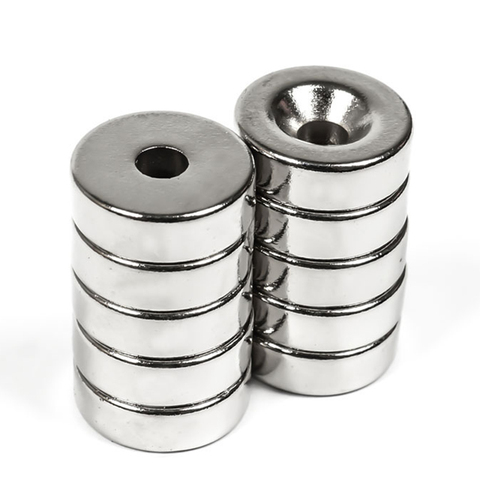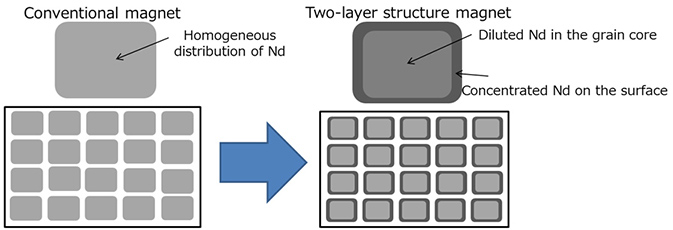N42 Sintered Ndfeb neodymium block magnets Neodymium (chemical symbol Nd) is element 60 on the periodic table. It is a rare earth metal and forms one of the Lanthanides series. A neodymium magnets (also known as NdFeB, NIB or Neo magnet), the most widely used type of rare-earth magnet, is a permanent magnet made from an alloy of neodymium, iron and boron to form the Nd2Fe14B tetragonal crystalline structure.

Ndfeb Magnet Properties
The neodymium magnet, also known as the NdFeB magnet, is a kind of artificial permanent magnet, also the most powerful permanent magnet to date. NdFeB magnets can attract objects up to 640 times their own weight. If divided by shape, the NdFeB magnets can be divided into round magnets, ring magnets, rectangular magnets, square magnets, and irregular magnets, etc. If divided according to their production process, NdFeB magnets can be divided into bonded NdFeB magnets and sintered NdFeB magnets. Bonded NdFeB magnets vs sintered NdFeBmagnets, what’s the difference between them? In this article, we will try to find the differences between bonded NdFeB magnets and sintered NdFeB magnets.
Bonded NdFeB Magnets
Bonded NdFeB magnet, composed of Nd2Fe14B, is a synthetic magnet. Bonded NdFeB magnets are magnets made of rapidly quenched NdFeB magnetic powder and binder by “compression molding” or “injection molding”.
Bonded NdFeB magnets have high dimensional accuracy, can be made into magnetic components with relatively complex shapes, and have the characteristics of one-time molding and multi-polar orientation. The bonded NdFeB magnets have high mechanical strength and can be formed at one time with other supporting components during forming.
Thanks to their low cost, high dimensional accuracy, the large degree of freedom in shape, good mechanical strength, and light specific gravity, bonded NdFeB magnets are widely used in office automation equipment, Denso machinery, audiovisual equipment, instrumentation, small motors and metering machinery, mobile phones, CD-ROM, DVD-ROM drive motors, hard disk spindle motors HDD, other micro special DC motors and automated instruments and other fields. Their annual growth rate has reached 35%.
Compared with sintered NdFeB magnets, bonded NdFeB magnets can be formed at one time without secondary processing, and can be made into various shapes of complex magnets, which is also incomparable to sintered magnets. With the help of the bonded NdFeB magnets, people can greatly reduce the size and weight of the motor.
Sintered NdFeB Magnets
The sintered NdFeB magnet is made by powder metallurgyprocess. First, the smelted alloy needs to be powdered and pressed into a compact in a magnetic field, and then the compact is sintered in inert gas or vacuum to achieve densification.
In general, only the magnet blank can be produced after sintering, and then it can be turned into magnets of various shapes through mechanical processing (such as wire cutting, slicing, grinding, etc.).
Sintered NdFeB permanent magnets are widely used in electronics, electrical machinery, medical equipment, toys, packaging, hardware machinery, aerospace, and other fields. The more common ones are permanent magnet motors, speakers, magnetic separators, computer disk drives, and magnetic resonance imaging equipment instruments.
Compared with bonded NdFeB magnets, sintered NdFeB magnets have high processing costs, large loss during processing, and poor dimensional accuracy. But its advantage is also obvious. At present, the (BH) max of sintered NdFeB magnet can reach more than 50M, while the bonded magnet is generally below 10M.


Neodymium Magnet
Conclusion
Ndfeb Magnet Datasheet
Thank you for reading our article and we hope it can help you to have a better understanding of the differences between bonded NdFeB magnets and sintered NdFeB magnets. If you want to know more about neodymium magnets, we would like to advise you to visit Stanford Magnets for more information.
Ndfeb Magnet Cost Per Kg
Stanford Magnets is a top magnet supplier across the world, who has been involved in R&D, manufacturing, and sales of magnets since the 1990s. It provides customers with high-quality rare earth permanent magnetic products such as neodymiummagnets, and other non-rare earth permanent magnets at a very competitive price.
